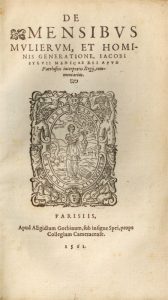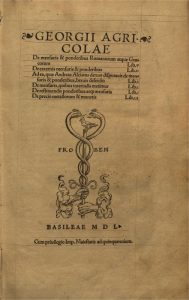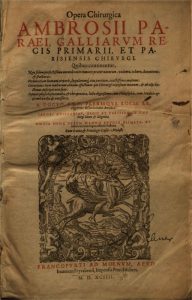If you were to look at where all of the pre-1800 books in our collections were published, you would notice that some cities show up over and over, such as Venice, Paris, Lyon, Basel, and Frankfurt. This makes sense, since these cities were some of the dominant print centers of the early modern period. Venice was already a well-established trade center, making it a good distribution point for printed books, and was also close to several paper mills. Paris and Basel were both university towns, with a built in demand for texts, and Frankfurt was the center of the Frankfurt Book Fair.
Some cities, on the other hand, appear much less frequently. One reason for this has to do with the focus of our collections. We’re a medical library, so we’re not likely to have any works originating in a city whose printing industry was heavily geared toward genres we don’t collect in – for example, we have hardly any works printed in Wittenberg because Wittenberg printers tended to focus on religious works. We also have very few works printed in Spain. Although the Iberian Peninsula had a large community of readers; its geography, political landscape, and linguistic diversity made it difficult for one city to rise to the forefront of printing, and many Spanish works were printed abroad in France and the Low Countries.[1] We do, however, have a few works that were printed in Madrid and Seville, two of the Spanish cities with fairly significant print industries. Of these, the most spectacular is probably our 1733 edition of the Spanish humanist Andrés de Laguna’s translation of Dioscorides’ herbal.
If Galen was the classical authority on anatomy, Pedanius Dioscorides (c. 40CE – 90) was the classical authority on pharmaceuticals. His work on the medicinal properties of plants, minerals, and animal products was written in five books c. 77CE and remained a standard text on materia medica for well into the early modern period. De Laguna published his Castilian translation and commentary on Dioscorides’ text in 1555 (in the Flemish city of Antwerp, then under Spanish control) and it proved immensely popular, going through twenty-two editions and even meriting a mention in Miguel Cervantes’ epic novel Don Quixote.
The edition published in Madrid by Domingo Fernandez de Arrojo, which was edited by Francisco Suarez de Ribera, has some lovely illustrations. In addition to several copperplate engravings depicting the various medicinal plants, this publication has two beautifully rendered full-page scenes. One of them is a fairly standard authorial portrait. Two medallions at the top of the page show Dioscorides and de Laguna himself, and below them another figure examines plants and herbals. This might be de Ribera, although I’m not certain. The other large illustration shows a scene with a classical/mythological flair. Two regal figures seem to be discussing the healing properties of plants, while Roman soldiers cluster in the distance.
Madrid might not have been an international printing center like Venice or Paris, but as this edition of Dioscorides shows, Spanish printers were certainly capable of printing beautiful works!
[1] For a discussion of the development of print centers in early modern Europe, see Andrew Pettegree’s The Book in the Renaissance (New Haven: Yale University Press, 2011).







